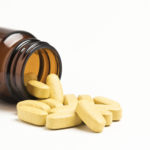Can Any B Vitamins Be Harmful?
Is there such a thing as too much of any of the B vitamins? If so, how much is too much and what problems can result?
Andrew Weil, M.D. | June 20, 2019

We used to think that B vitamins were harmless because, being water-soluble (like vitamin C), they can’t accumulate in the body like the fat-soluble vitamins (A, D, E, and K). However, we now know that a high intake of certain B vitamins can be troublesome. The latest on this comes from a study published in May 2019 showing that postmenopausal women who had the highest daily intakes of B6 and B12 were more likely than women with the lowest intakes of these two vitamins to have hip fractures. Researchers who followed 75,864 women in the U.S. for an average of 21 years determined that the risk of hip fractures was 47 percent higher than normal among those who took 35 milligrams or more of B6 and 20 micrograms or more of B12 daily. The risk also was high among women who took large daily amounts of either vitamin. Half the fractures occurred in women under the age of 76.
We also know that vitamin B6 (pyridoxine) can cause nerve toxicity, although it usually doesn’t do that in doses lower than 200-300 mg per day. Over time, higher doses of B6 can cause numbness and tingling in the extremities that may eventually be irreversible. (I saw one woman who developed numbness in her legs from a daily dose of just 200 mg. A neurologist told her she might have multiple sclerosis, but when she stopped taking the B6, the symptoms disappeared.) I recommend a trial of 100 to 200 mg per day of this vitamin for nerve compression injuries such as carpal tunnel syndrome, but I always caution patients to discontinue it if they notice any unusual sensations. Too much B6 can also cause oversensitivity to sunlight, which, in turn, can lead to skin rashes, as well as nausea, vomiting, abdominal pain, loss of appetite, and abnormal liver function.
High doses of niacin (vitamin B3) can also cause problems, but you’re unlikely to run into trouble unless you’re taking more than 2,000 to 3,000 mg per day in efforts to lower cholesterol. Reactions range from flushing, itching, nervousness and headache to intestinal cramps. Don’t take doses in excess of 3,000 mg a day except under careful medical supervision. At those amounts nausea, jaundice and elevated liver enzymes can occur, a toxic picture mimicking hepatitis. The symptoms disappear when niacin is discontinued.
Don’t take high doses of niacin if you’re pregnant, have ulcers, gout, diabetes, gallbladder disease, liver disease, or have had a recent heart attack. Anyone who takes this B vitamin to lower cholesterol should do so only under a physician’s supervision and should have liver function tests before the start of therapy and periodically thereafter. You also should monitor your cholesterol monthly and keep your niacin dose to the lowest possible level to maintain improvement.
The healthiest way to ensure that you’re getting all the B vitamins and other nutrients you need is to eat a varied diet that includes fruit, vegetables, whole grains, legumes and other sources of plant protein, as well as some animal foods.
Andrew Weil, M.D.
Source:
Haakon E. Meyer et al, “Association of High Intakes of Vitamins B6 and B12 From Food and Supplements with Risk of Hip Fracture Among Postmenopausal Women in the Nurses’ Health Study,” JAMA Network Open, May 10, 2019, doi:10.1001/jamanetworkopen.2019.3591













